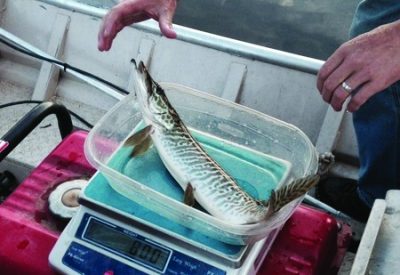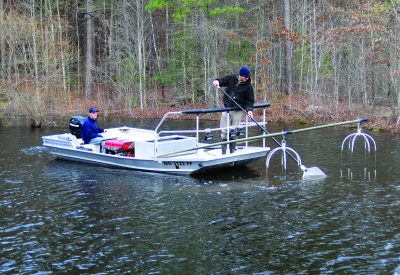By: Steven King, Field Manager at SOLitude Lake Management
Whether you’re interested in creating a prized trophy fishery or just want to improve the health and longevity of your fishing pond, electrofishing is an essential tool for fisheries managers. This method is the primary sampling technique used to gather necessary information about the current state of a waterbody and determine what can be done to meet or exceed the goals of the specific fishery.
What exactly is electrofishing? Electrofishing helps biologists track reproductive success and survival rates of fish species. The assessment is performed by sending an electric current into the water in order to safely stun any nearby fish. Stunned fish can then be easily scooped up in a net and placed in a temporary holding tank where they can revive and be observed for data collection. Most often, fish are measured, weighed and marked with PIT or Floy tags, which are used to determine the health and growth of the fish year over year. Then, they are released back into the water completely unharmed.
How does it work? Electrofishing requires a crew of properly trained and licensed professionals as well as a specialized boat, which is often custom built. While electrofishing boats can vary in design, they are all outfitted with the same equipment, including a generator and redundant safety features. The generator directs an AC electric 
What are the benefits of an electrofishing assessment? First, this method captures a large and diverse sample of fish in a short period of time, without the need to catch every fish in the waterbody. By using information from this sample, biologists can collect data on species abundance, size structure and condition—which, in turn, can be used to determine which strategies could be implemented to meet the goals of the fishery. These strategies may include, but are not limited to stocking, harvest restrictions, water quality improvements, fertilization, feeding and habitat management.
Biologists can use this method to inspect each fish for the presence of sores or parasites, and identify any prevalent problems throughout the fish populations that would otherwise go unnoticed. Electrofishing can also help expose any unwanted or invasive fish species that are causing harm to the beneficial fish populations or impeding the long-term goals of the fishery. In some cases, the removal of nuisance or invasive species is necessary to most effectively meet the management plan of a lake or pond. These unwanted fish can be removed through electrofishing.
An electrofishing assessment should always be considered at the beginning of a new lake, pond or fisheries management plan, and later implemented on a 1- to 5-year basis depending on the goals of the fishery. Lakes and ponds are constantly changing from year to year, and regular assessments will make it possible to consistently implement the best management practices and make necessary adaptations to the plan when needed. So, whether you’re looking to manage your body of water for prized catches, casual fishing, or just want to know what kind of fish are present, your lake management specialist can assess the wildlife in your waterbody and help you make the best decisions for the growth and enhancement of your lake or pond.
Steven King is a Field Manager at SOLitude Lake Management, an environmental firm providing full service lake, pond, and fisheries management services throughout the United States. He can be reached through the website, www.solitudelakemanagement.com.

